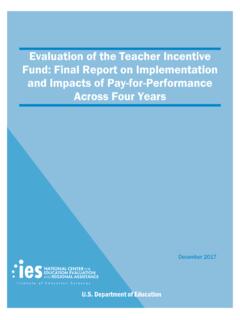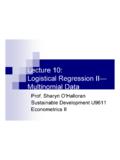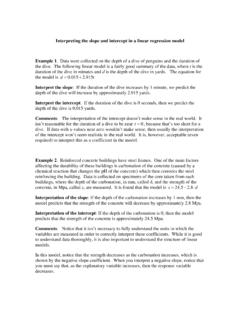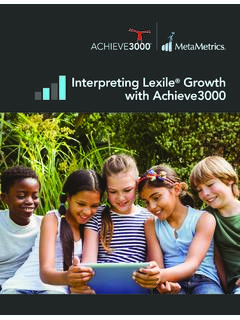Transcription of A Primer for Analyzing Nested Data: Multilevel Modeling in ...
1 REL 2015 046 The National Center for Education Evaluation and Regional Assistance (NCEE) conducts unbiased large-scale evaluations of education programs and practices supported by federal funds; provides research-based technical assistance to educators and policymakers; and supports the synthesis and the widespread dissemination of the results of research and evaluation throughout the United States. December 2014 This report was prepared for the Institute of Education Sciences (IES) under contract ED-IES-12-C-0009 by Regional Educational Laboratory Northeast & Islands administered by Education Development Center, Inc. (EDC). The content of the publication does not necessarily reflect the views or policies of IES or the Department of Education nor does mention of trade names, commercial products, or organizations imply endorsement by the Government.
2 This REL report is in the public domain. While permission to reprint this publication is not necessary, it should be cited as: O Dwyer, L. M., and Parker, C. E. (2014). A Primer for Analyzing Nested data : Multilevel mod eling in SPSS using an example from a REL study (REL 2015 046). Washington, DC: Department of Education, Institute of Education Sciences, National Center for Educa tion Evaluation and Regional Assistance, Regional Educational Laboratory Northeast & Islands. Retrieved from This report is available on the Regional Educational Laboratory website at ncee/edlabs. Summary Researchers often study how students academic outcomes are associated with the charac teristics of their classrooms, schools, and districts.
3 They also study subgroups of students such as English language learner students and students in special education. However, district personnel may not be aware that commonly used analytic methods might give inaccurate readings of the statistical significance of results when individual (student) data are Nested within groups (classrooms, programs, schools) or when group-level data are disaggregated to predict individual outcomes. In these cases, it may be necessary to use Multilevel regression Modeling (also known as hierarchical linear Modeling or linear mixed Modeling ) to analyze data . This Primer on conducting Multilevel regression analy ses to address these issues using the Advanced Statistics module of SPSS IBM Statistics should be useful to applied researchers and district staff engaged in or in charge of data analysis.
4 A recent study by Regional Educational Laboratory Northeast & Islands focusing on the achievement of a cohort of English language learner students (Parker, O Dwyer, & Irwin, 2014) asked which characteristics of students, English language learner programs, and schools were most closely related to the students English proficiency scores. Such research is often addressed using a prediction Modeling technique called ordinary least squares (OLS) regression. OLS regression is used to examine the strength and direction of the rela tionship between two variables in a statistical model while holding other variables con stant. It is used extensively as an exploratory, explanatory, and predictive tool.
5 However, a standard OLS model may not be appropriate in situations where individuals are Nested in groups because nesting may lead to a statistical dependency among the observations in the Statistical dependencies can occur for multiple reasons, including situations in which indi viduals share the same educational context where individuals are Nested in classrooms or schools and situations in which group-level characteristics are used to predict individ ual outcomes. An example of the first situation is English language learner students who attend the same school. These students are likely to be more similar to each other than to individuals in other schools (they are drawn from the same communities, use similar school resources, have the same teachers), and so statistical dependency may occur.
6 The second situation occurs when the analysis aims to examine the relationships between group char acteristics and individual outcomes. Because each individual in a group is assigned the same value for a group characteristic, a statistical dependency can occur. In the presence of statistical dependency and assuming that the model is correctly speci fied, standard OLS regression can produce unbiased estimates of the relationships between variables (the regression coefficients). However, the standard errors associated with the regression coefficients may be biased, leading to incorrect conclusions about the statistical significance of the observed relationships.
7 One of the key assumptions of OLS models (and several other common analysis procedures) is that each individual provides a unique piece of statistical information that is unrelated to the information provided by other individuals in the sample. Statistical dependency violates this assumption and can lead to downwardly biased estimates of the standard errors associated with the regression coefficients and ulti mately to incorrect statistical conclusions. i Multilevel regression Modeling does not correct bias in the regression coefficient estimates compared with an OLS model; however, it produces unbiased estimates of the standard errors associated with the regression coefficients when the data are Nested , and easily allows group characteristics to be included in models of individual outcomes (Snijders & Bosker, 1999; Raudenbush & Bryk, 2001; Bickel, 2007, Gelman & Hill, 2007; Hox, 2010).
8 Although Multilevel Modeling is an advanced data analysis procedure that requires specialized software and data analysis skills, several readily available statistical packages provide the capability to conduct such analyses, including the Advanced Statistics module of SPSS IBM Statistics, used for the analysis in this Primer . ii Contents Summary i Why this Primer ?
9 1 Challenges in using ordinary least squares regression analysis with Nested data 3 Statistical significance tests evaluate the strength of relationships 4 Danger of false-positive or false-negative errors 4 Analyzing Nested data with Multilevel Modeling 4 Accounting for statistical dependency 5 Variance and covariance can be partitioned into within-group and between-group components 5 Comparing the two statistical models 6 Sample size is important 7 An illustration using English language learner student and school data 7 Two-level model used to predict English proficiency scores 7 interpreting the results of ordinary least squares and Multilevel regression models 8 Implications of statistical dependency 10 Appendix A Step by step procedure for using the Advanced Statistics module of SPSS IBM Statistics A-1 Notes Notes-1 References Ref-1 Box 1 Key terms 2 Table 1 Comparison of results for a Multilevel model and an ordinary least squares model predicting English language learner students scores on a test of English proficiency 8 iii Why this Primer ?
10 A recent study by the Regional Educational Laboratory Northeast & Islands on the achievement of a cohort of English language learner students in a large school district in Connecticut asked which characteristics of students, English language learner programs, and schools were most closely related to the students English proficiency scores (Parker et al., 2014). A common statistical method used to address this type of question is ordinary least squares (OLS) regression analysis. OLS regression, which can examine the strength and direction of the relationship between two variables while holding other variables constant, is used extensively as an exploratory, explanatory, and prediction tool.














